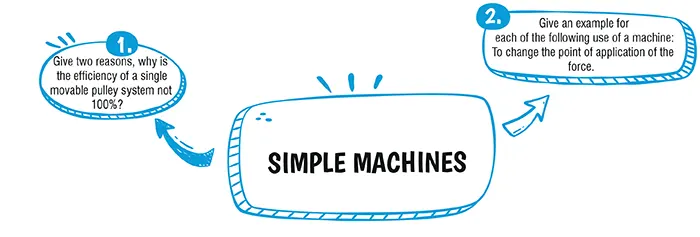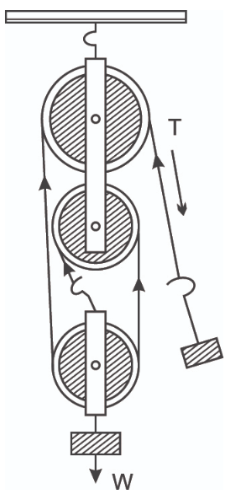Table of Contents

Ans. (c) external agency supplied to the machine
Explanation:
In the context of mechanics and machines, effort is the external force or input used to operate a machine by an external agency, usually a human or a mechanical power source. It is the power or force used to propel a machine to carry out a certain function, such as moving an object or lifting a load. The machine uses this effort to overcome impediments (such as friction, gravity, or other forces) and complete the desired task.
Ans. (d) all of the above
Explanation:
The velocity ratio in a simple machine or mechanical system is a measure of how the velocity of the effort (input) compares to the velocity of the load (output). It is calculated by dividing the velocity of effort by the velocity of the load.
Ans. Two reasons are as follows:
Explanation:
Examples are as follows:
(i) Rotating the wheel of a cycle by applying force on the paddle with the help of a chain.
(ii) Lifting a car with a jack.
(iii) Lifting a bucket full of water from a well using a single fixed pulley.

Explanation:
The load lifted would be maximum when conditions are ideal. Since this setup uses three strands of string, the load gets raised only through 1/3rd of the distance through which the effort moves. Hence,
Velocity ration = \dfrac{\text{Distance moved by the effort}}{\text{Distance moved by the load}}\\
= \dfrac{1}{1/3} = 3 Under ideal conditions, V.R. = M.A
Hence, Ideal M.A. of the setup = 3.
∴ Maximum load that can be lifted
= Effort × 3 = 1000 N × 3
= 3000 N.Under actual conditions, M.A.
= \dfrac{\text{Load}}{\text{Effort}}\\[4.5 bp]= \dfrac{2700N}{1000N}\\[4.5 bp]\therefore \space \space \space \text{Efficiency = } \dfrac{M.A}{V.R.} = \dfrac{2.7}{3}\\[4.5 bp]= 0.9 = 90%
Download Mind Map of this chapter
Download NowWant to Practice Mock Tests of this chapter
Practice NowDownload Important Questions of this chapter
Download Now| Chapter No. | Chapter Name |
|---|---|
| Chapter 1 | Force Work Power and Energy |
| Chapter 2 | Simple Machines |
| Chapter 3 | Refraction of Light |
| Chapter 4 | Refraction Through Lenses |
| Chapter 5 | Spectrum |
| Chapter 6 | Sound |
| Chapter 7 | Electricity |
| Chapter 8 | Electrical Power and Household Circuits |
| Chapter 11 | Magnetic Effect of Current |
| Chapter 12 | Specific Heat Capacity and Latent Heat |
| Chapter 13 | Radioactivity and Nuclear Energy |
| Chapter Wise Important Questions for ICSE Board Class 10 Physics |
|---|
| Force Work Power and Energy |
| Simple Machines |
| Refraction of Light |
| Refraction Through Lenses |
| Spectrum |
| Sound |
| Electricity |
| Electrical Power and Household Circuits |
| Magnetic Effect of Current |
| Specific Heat Capacity and Latent Heat |
| Radioactivity and Nuclear Energy |
CBSE Important Questions Class 10
ICSE Important Questions Class 10
CBSE Important Questions Class 10
ICSE Important Questions Class 10